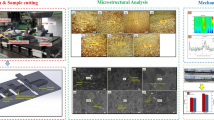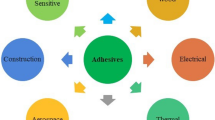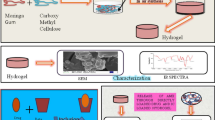Abstract
In this work, nano-alumina was utilized as a reinforcing agent for guar gum, with an aim to improve its performance properties; especially, mechanical and barrier i.e. water vapor transmission rate (WVTR). Films were prepared by the process of solution casting. Concentration of nano-alumina was varied as 0, 1, 3, 5 and 7 parts per hundred parts of resin (phr) in guar gum. The prepared pristine and guar gum/alumina nano-composite films were characterized for mechanical, puncture, x-ray diffraction, barrier, rheological and morphological properties. Tensile strength, Young’s modulus, puncture strength, viscosity and crystallinity increased; whereas, WVTR, elongation at break (%) and damping factor decreased with increased concentration of nano-alumina in guar gum. However, optimized improvement in the performance properties were determined for 5 phr nano-alumina loaded guar gum polymer matrix, attributed to its better dispersion and interaction into the guar gum polymer chains due to the hydrophilic nature of both the materials. Above 5 phr concentration nano-alumina started forming aggregates, as evident from scanning electron microscopy.







Similar content being viewed by others
References
Bismarck A (2008) Are hierarchical composite structures the way forward to improve the properties of truly green composites. Express Polym Lett 2:687–687
Choi Y, Simonsen J (2006) Cellulose nanocrystal-filled carboxymethyl cellulose nanocomposites. J Nanosci Nanotechnol 6(3):633–639
D’Mello D, Sabnis A, Shenoy MA, Kathalewar M (2012) Preparation of acetylated guar gum – unsaturated polyester composites and effect of water on their properties. Curr Chem Lett 1(4):147–156
Dorgan JR, Lehermeier HJ, Palade L-I, Cicero J (2001) Polylactides: properties and prospects of an environmentally benign plastic from renewable resources. Macromol Symp 175(1):55–66
Huang M, Yu J, Ma X (2006) High mechanical performance MMT-urea and formamide-plasticized thermoplastic cornstarch biodegradable nanocomposites. Carbohydr Polym 63(3):393–399
Hule RA, Pochan DJ (2007) Polymer nanocomposites for biomedical applications. MRS Bull 32(4):354–358
Kadam PG, Mhaske ST (2011) Synthesis and properties of polyamide derived from piperazine and lower purity dimer acid as hot melt adhesive. Int J Adhes Adhes 31(7):735–742
Kadam P, Mhaske S (2012) Effect of piperazine concentration on the properties of lower purity dimer acid synthesized polyamidehot-melt adhesive. J Adhes Sci Technol 26(8–9):1267–1279
Kadam P, Mhaske S (2014) Effect of extrusion re-processing on the mechanical, thermal, rheological and morphological properties of nylon-6/talc nanocomposites. J Thermo Plast Compos (Accepted manuscript)
Kadam P, Kute R, Mhaske S (2013a) Effect of Nano-alumina concentration on the properties of poly (vinyl chloride)/thermoplastic polyester elastomer blend system. Iran Polym J 22(8):549–560
Kadam PG, Kute RA, Mhaske ST (2013b) Synthesis and characterization of a novel polyesteramide from modified Jatropha seed oil, dimer acid and ethylenediamine as hot melt adhesive. J Adhes Sci Technol 28(7):675–689
Kadam P, Vaidya P, Mhaske S (2014) Synthesis and characterization of polyesteramide based hot melt adhesive obtained with dimer acid, castor oil and ethylenediamine. Int J Adhes Adhes 50:151–156
Karande VS, Bharimalla AK, Vighneshwaran N, Kadam PG, Mhaske ST (2014) Cotton linter Nano-fibers as the potential reinforcing agent for guar gum. Iran Polym J 23(11):869–879
Lu Y, Weng L, Zhang L (2004) Morphology and properties of soy protein isolate thermoplastics reinforced with chitin whiskers. Biomacromolecules 5(3):1046–1051
Lu Y, Weng L, Cao X (2006) Morphological, thermal and mechanical properties of ramie crystallites—reinforced plasticized starch biocomposites. Carbohydr Polym 63(2):198–204
Lu DR, Xiao CM, Xu SJ (2009) Starch-based completely biodegradable polymer materials. Express Polym Lett 3(6):366–375
Petersson L, Kvien I, Oksman K (2007) Structure and thermal properties of poly(lactic acid)/cellulose whiskers nanocomposite materials. Compos Sci Technol 67(11):2535–2544
Rane L, Savadekar N, Kadam P (2014) Mhaske S preparation and characterization of k-carrageenan/Nano-silica bio-composite film. J Mater 2014:1–8
Rithe S, Kadam P, Mhaske S (2014) Synthesis and properties of hydrogels prepared from the blend of guar gum and chitosan, Cross-linked with Glutaraldehyde. Adv Mater Sci Eng Int J (accepted manuscript)
Savadekar NR, Mhaske ST (2012) Synthesis of nano cellulose fibers and effect on thermoplastics starch based films. Carbohydr Polym 89(1):146–151
Savadekar NR, Karande VS, Vigneshwaran N, Bharimalla AK, Mhaske ST (2012) Preparation of nano cellulose fibers and its application in kappa-carrageenan based film. Int J Biol Macromol 51(5):1008–1013
Savadekar NR, Kadam PG, Mhaske ST (2013) Studies on the effect of Nano-alumina on the performance properties of poly (butyleneadipate-co-terephthalate) composite films. J Thermoplast Compos doi: 0892705713513292
Savadekar N, Karande V, Vighneshwaran N, Bharimalla A, Kadam P, Mhaske S (2014) Preparation of cellulose nano-whiskers and its effect on performance properties of k-carrageenan. J Biobased Mater Bioener (accepted manuscript)
Shimazaki Y, Miyazaki Y, Takezawa Y, Nogi M, Abe K, Ifuku S, Yano H (2007) Excellent thermal conductivity of transparent cellulose nanofiber/epoxy resin nanocomposites. Biomacromolecules 8(9):2976–2978
Soradech S, Nunthanid J, Limmatvapirat S, Luangtana-Anan M (2012) An approach for the enhancement of the mechanical properties and film coating efficiency of shellac by the formation of composite films based on shellac and gelatin. J Food Eng 108(1):94–102
Svagan AJ, Hedenqvist MS, Berglund L (2009) Reduced water vapor sorption in cellulose nanocomposites with starch matrix. Compos Sci Technol 69(3):500–506
Thakur VK, Singha AS (2010) Natural fibres-based polymers: part 1-mechanical analysis of pine needles reinforced biocomposites. Bull Mater Sci 339(3):257–264
Tokiwa Y, Calabia BP, Ugwu CU, Aiba S (2009) Biodegradable plastics. Int J Mol Sci 10(9):3722–3742
Wasekar P, Kadam P, Mhaske S (2014) Preparation of zinc and calcium hydroxide-modified fly ash and its utilization as filler in nylon 6. J Thermo Plast Compos. doi:10.1177/0892705714551239
Wongpanit P, Sanchavanakit N, Pavasant P, Bunaprasert T, Tabata Y, Rujiravanit R (2007) Preparation and characterization of chitin whisker-reinforced silk fibroin nanocomposite sponges. Eur Polym J 43(10):4123–4135
Yeole K, Kadam P, Mhaske S (2014) Synthesis and characterization of fly ash-zinc oxide nanocomposite. J Mater Res Technol 3(2):186–190
Acknowledgments
The authors gratefully acknowledge the financial support provided by The University Grant Commission under the SAP-DRS scheme for the present work. Authors are also grateful to the Institute of Chemical Technology for the research facilities provided to perform this research work.
Author information
Authors and Affiliations
Corresponding author
Additional information
Research highlights
• Utilization of nano-alumina to improve the performance property of guar gum
• Appreciable improvement in mechanical and barrier properties
• Showed non-Newtonian shear-thinning and non-thixotropic flow behavior
• 5 phr is the optimized concentration of nano-alumina to be added in guar gum
• Possible application in food and pharmaceutical packaging
Rights and permissions
About this article
Cite this article
Savvashe, P., Kadam, P. & Mhaske, S. Effect of nano-alumina concentration on the mechanical, rheological, barrier and morphological properties of guar gum. J Food Sci Technol 53, 1948–1956 (2016). https://doi.org/10.1007/s13197-015-2114-7
Revised:
Accepted:
Published:
Issue Date:
DOI: https://doi.org/10.1007/s13197-015-2114-7




